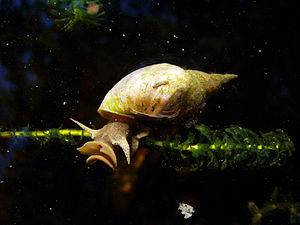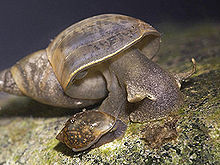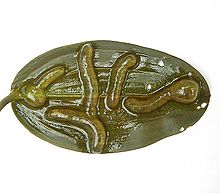Mud snail
| Mud snail | ||||||||||||
|---|---|---|---|---|---|---|---|---|---|---|---|---|

European mud snail ( Lymnaea stagnalis ) |
||||||||||||
| Systematics | ||||||||||||
|
||||||||||||
| Scientific name | ||||||||||||
| Lymnaea stagnalis | ||||||||||||
| ( Linnaeus , 1758) |
The pointed mud snail ( Lymnaea stagnalis ), also known as pointed horn snail, belongs to the family of mud snails and is the largest water lung snail in Central Europe with a shell length of 4.5 to a maximum of 7 centimeters .
features
The species has a right-handed, relatively thin-skinned, horn-brown housing with 7.5 turns and a long tip. The navel is closed. The first turns increase evenly, while the last turn increases very quickly and is bulbous. However, the housings show considerable intra-species variability, for example depending on the habitat. Specimens in the surf zones of large lakes have shortened threads and a wider mouth with a foot. Animals that live in the moving water of reed beds form a hook on the outer edge of the mouth, with which they clasp reed stalks. The soft body is gray to brown in color. The antennae are large and triangular; at its base are the eyes.
Distribution, habitat and way of life

The European mud snail is Holarctic . In Scandinavia the distribution area extends to northern Norway. In Central Europe it occurs up to an altitude of 1700 m. The species is found very often in larger ponds, ponds, lakes, ditches and lowland rivers with rich underwater weeds.
It tolerates pH values of 6.5 to 9, so it is absent, for example, in acidic bog waters and other lime-poor habitats. It can survive the temporary drying out of its habitat and the freezing of water in winter. In addition, salt contents of up to 0.7 percent can be tolerated, and so the European mud snail is also found in the northern Baltic Sea , where however, with a shell length of 20 to 30 mm, it remains significantly smaller. From a water temperature of 26 ° C, mortality increases sharply due to lack of oxygen.
The food spectrum primarily includes algae , soft and rotting parts of other aquatic plants, organic suspended matter and sediment ( detritus ), but also carrion and the spawn of various animals. The snail moves on a slime track and can even slide along the surface of the water on the underside of the membrane. She is also able to swim freely up or down. She rolls her body up into a kind of tube and points her head in the desired direction. This can be observed particularly in the growth phase of medium-sized animals. She comes to the surface to breathe and fills her mantle cavity with air. But oxygen is also absorbed from the water through skin breathing through the intensely perfused sensors . In the event of danger, it emits hemolymph as well as air and sinks to the bottom. She recovers from this stress reaction after about 24 hours. If they reproduce strongly, European mud snails can displace other snail species in smaller bodies of water. When overpopulated, they also eat their own spawn.
The bristle worm Chaetogaster limnaei sometimes lives socially on mud snails . They are also intermediate hosts of sucking worm larvae of the species Trichobilharzia ocellata , later called cercaria (compare also bath dermatitis ).
The saprobic index for the European mud snail is 1.9.
Reproduction

The hermaphrodite animals are sexually mature at about 10 weeks, but do not fertilize each other, but always in one direction. After fertilization, gelatinous spawning cords are attached to aquatic plants, which can contain up to 200 eggs. Depending on the water temperature, the fully developed young hatch from the eggs after about 14 days. They can live to be three to four years old.
Systematics
DNA studies and crossbreeding experiments have shown that populations previously identified as Lymnaea stagnalis are in fact separate species. Therefore, the specified range is possibly given much too broadly.
attitude
White mud snails can be kept very easily in a cold water basin at room temperature. Avoid direct sunlight. They eat different kinds of vegetables, lettuce, cabbage, dandelion leaves, but also aquatic plants, algae and fish food. With the latter, they accept both flakes and food tablets. In lettuce and other vegetables, make sure that it does not use pesticides is loaded. If food is left in the water for a long time and is broken down in the process, nitrate is produced through nitrification . Frequent removal of leftover food and regular water changes are necessary. A piece of sepia shell for the lime supply is gladly accepted and is also important depending on the water hardness .
The common mud snails also graze the lawns of the green hydra ( Hydra viridissima ) in the aquarium and are a biological means of reducing the infestation by these freshwater polyps . Other species of snail spawn, e.g. B. the spring bladder snail ( Physa fontinalis ), is also eaten.
literature
- Rosina Fechter / Gerhard Falkner: Mollusks. European marine and inland mollusks. Steinbach's natural guide, Mosaik-Verlag, Munich 1990, ISBN 3-570-03414-3
- Peter Glöer: The animal world of Germany. Mollusca I: Freshwater gastropods from Northern and Central Europe. Identification key, way of life, distribution. ConchBooks, Hackenheim 2002, 2. neubearb. Ed., ISBN 3-925919-60-0
- Gertrud Müller: Morphology, life cycle and place of formation of the blood cells of Lymnaea stagnalis L. Cell and Tissue Research, 44 (5), 1956
Individual evidence
- ^ Gertrud Müller: Morphology, life course and place of formation of the blood cells of Lymnaea stagnalis L. Cell and Tissue Research, 44 (5), 1956
- ↑ Meyer, Detlef .: Macroscopic biological field methods for assessing the water quality of rivers: with lists of species for beginning and experienced investigators and detailed descriptions and images of the indicator organisms . 4th, unchanged edition. BUND, Hannover 1990, ISBN 3-9800871-4-X .
Web links
- Information and pictures at www.weichtiere.at
- Information at www.laubfrosch-hannover.de
- Lymnaea stagnalis inthe IUCN 2013 Red List of Threatened Species . Posted by: Budha, PB, Dutta, J. & Daniel, BA, 2010. Retrieved September 23, 2013.


